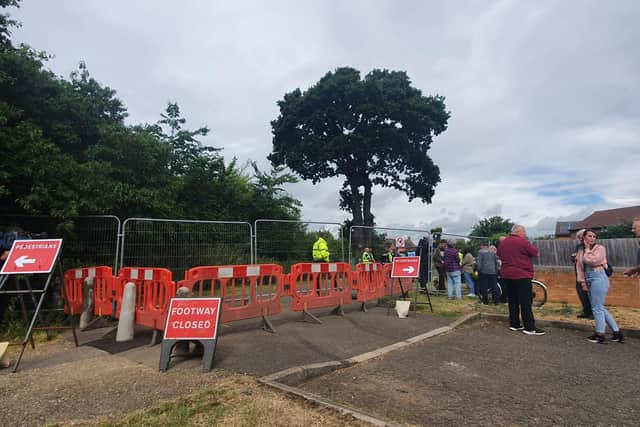Financial burden of subsidence caused by trees leave council with £1.13m bill and prompts changes to Peterborough's tree management plan
and live on Freeview channel 276
A new policy for managing the city’s trees has been drafted and will be discussed at the Climate Change and Environment Scrutiny Committee next month.
Intense scrutiny has been put on the council ever since it took the decision to fell the Bretton Oak Tree in response to the insistence of an insurance company that the roots of the ancient oak were causing damage to the foundations of a nearby home.
Advertisement
Hide AdAdvertisement
Hide AdDespite a year-long battle with protestors, the council eventually felled the tree in June and spent £49,000 doing so. The council had insisted that not felling the tree could have led to a bill for hundreds of thousands of pounds.


A new council report has now shown that between 2013 and 2019, proven claims of tree-related subsidence- when clay soil shrinks when dried up by tree roots taking in nutrients and causes damage to property, this was claimed to the be case with the Bretton Oak, but is still disputed by protestors, totalled £1.13m.
In 2018, costs to the council to either pay out or remove trees totalled around £450,000- a record high.
The report states that the summer of 2018 is considered to be an exceptional one in 42 years event, however, the particularly dry summer of this year, is likely to be even more exceptional. It adds that “There is no doubt the increasing trend on the value of claims per annum will continue unless appropriate action is taken.”
Advertisement
Hide AdAdvertisement
Hide AdThe report has described these costs as a ‘significant financial burden’ and has contributed to the council’s new plans to manage its tree stock; along with the ageing tree stock.
The review includes a new banding system for assessing the environmental value of council-owned trees. It also includes a suggestion to bring any council-owned TPO tree recommended for felling due to subsidence to the city council’s Planning and Environmental Protection Committee.
Actions within the new proposed tree management policy are:
· Greater transparency of evidence submitted to substantiate claims – Request consent to publish the evidence that insurers have compiled to prove their claim against the council.
Advertisement
Hide AdAdvertisement
Hide Ad· Refer felling of any TPO council-owned trees to the Planning and Environmental Protection Committee – This would allow a public consultation into all proposed fellings of TPO council-owned trees, allow members of the public to speak in the public domain and hand over the decision to a cross-party committee.
· More information on age and value of the tree to the population – To communicate the approximate age of the tree and its nationally recognised Capital Asset Value for Amenity Trees (CAVAT) value as a public asset.
· Develop a banding system to assess the community value of trees – The proposed process (high, medium or low value) has been developed according to the capital asset valuation of tree stock.
High value trees would follow the current consultation protocol - however, insurers would be asked if alternative approaches would be considered.
Advertisement
Hide AdAdvertisement
Hide AdA broader council budget could also be used for this, however spending would need to be prioritised as this is also used for essential services, such as bin collections, education and social care for both adults and young people.
Councillor Nigel Simons, cabinet member for Peterborough City Council, said: “This new tree management policy shows what the council could do in future situations to potentially release more information about trees that are proposed to be felled and how it might change its decision-making processes for the highest value trees in our city.
“Our tree stock is an important community and environmental asset to our city. As it ages, decisions need to be made on how we can manage this tree stock, while preserving as many trees as possible for future generations to enjoy. This policy shows how improvements could be made to our current process, while pointing out the challenges that the council must abide by, including data protection laws, liaising with tree insurers on mitigation methods and financial pressures.”
